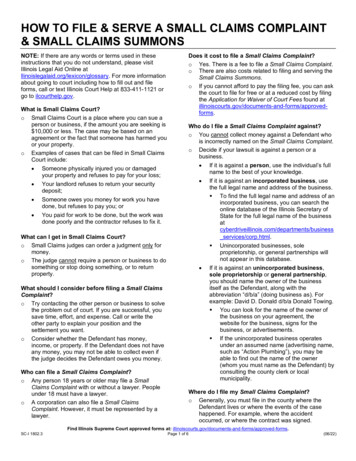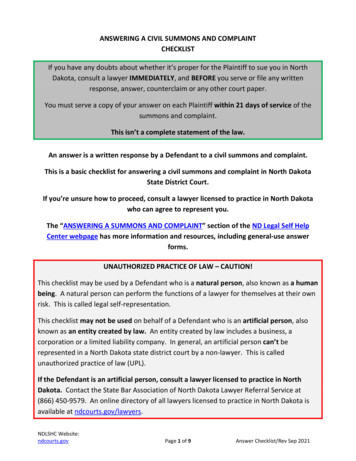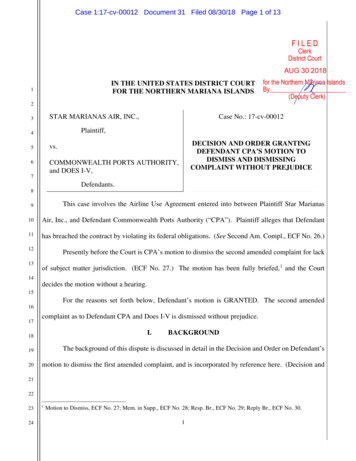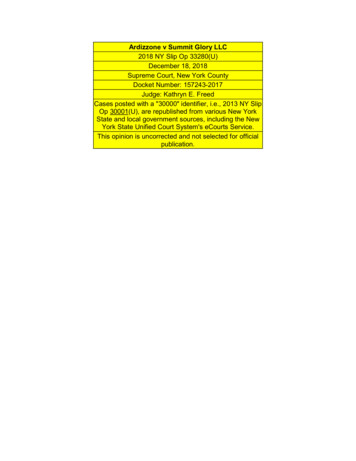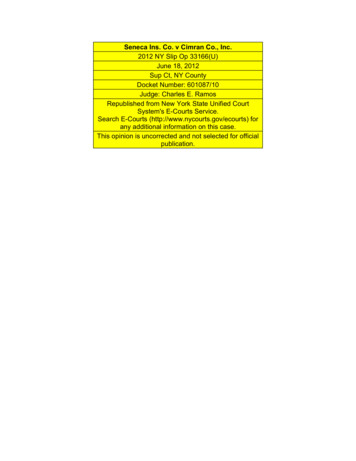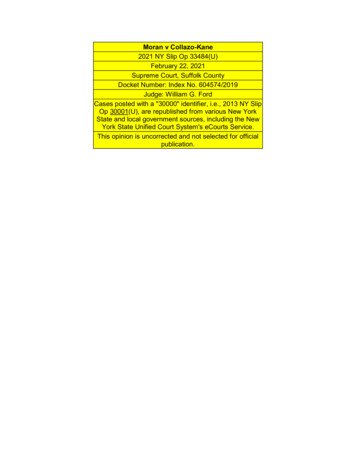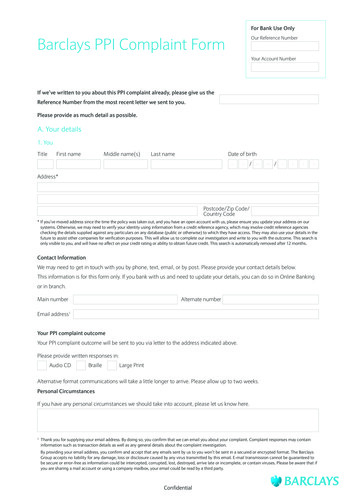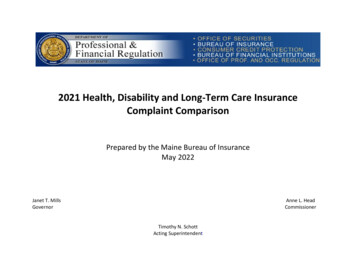
Transcription
1234UNITED STATES DISTRICT COURT5NORTHERN DISTRICT OF CALIFORNIA67AARON MICHAEL HASSAY,Case No. 17-cv-03556-JCSPlaintiff,ORDER DISMISSING COMPLAINTUNDER 28 U.S.C. § 1915 WITH LEAVETO AMEND8v.910DEPARTMENT OF THE ARMY,Defendant.United States District CourtNorthern District of California111213I.INTRODUCTION14Plaintiff Aaron Hassay filed this pro se action against Defendant the Department of the15Army (the ―Army‖), asserting negligence claims under the Federal Tort Claims Act (―FTCA‖).16Having previously granted Mr. Hassay‘s Application to Proceed in Forma Pauperis, the Court now17considers whether Mr. Hassay‘s Complaint should be dismissed under 28 U.S.C. § 1915(e)(2)(B),18which requires dismissal of an in forma pauperis complaint that is (1) frivolous or malicious, (2)19fails to state a claim on which relief may be granted, or (3) seeks monetary relief from a defendant20who is immune from such relief. Plaintiff has consented to the jurisdiction of the undersigned21United States Magistrate Judge pursuant to 28 U.S.C. § 636(c). For the reasons stated below, the22Court dismisses Mr. Hassay‘s complaint with leave to amend and vacates the Case Management23Conference currently scheduled for September 22, 2017 at 2:00 p.m.24II.25THE COMPLAINTMr. Hassay filed a form complaint on June 20, 2017 in which he named the Army as the26defendant. Compl. (dkt. 1) at 3. Mr. Hassay attached to his complaint a number of exhibits,27including documents from Mr. Hassay‘s social security claim, response letters from his28information request, and other documents concerning his disability status. The Court will refer to
1these documents collectively as ―Complaint Exhibits.‖ A court may consider evidence on which2the ―complaint ‗necessarily relies‘ if: (1) the complaint refers to the document; (2) the document3is central to the plaintiff‘s claim; and (3) no party questions the authenticity of the copy attached.‖4Marder v. Lopez, 450 F.3d 445, 448 (9th Cir. 2006) (quoting Branch v. Tunnell, 14 F.3d 449, 453–554 (9th Cir. 1994)); Fed. R. Evid. 201(b); Fed. R. Civ. P. 10(c) (―A copy of any written instrument6which is an exhibit to a pleading is a part thereof for all purposes.‖). As these requirements are7met, the Court will consider these documents in accessing the Complaint.8United States District CourtNorthern District of California9According to Mr. Hassay, in 1994 he enlisted with the Navy Reserve Program for an eightyear obligation. Compl. at 3. At that time, the U.S. Military Entrance Processing Command10(―MEPCOM‖) determined Mr. Hassay, who was eighteen years old, was healthy according to the11Physical Serial System (―PULHES‖). Id. From 1994 through 1999, Mr. Hassay was assigned to12the FFG Guided Missile Frigate. Id. Mr. Hassay claims he experienced mental and physical13illness while in this role. Id. A letter dated September 4, 2013 from the San Francisco Vet Center,14which was attached to the Complaint, states that Mr. Hassay was ―depressed, isolated, and fearful15of being trapped on a ship with people who would attack him physically and verbally.‖ Compl.16Exs. at 13–14.17In 1998, Mr. Hassay applied to transfer to the Army. Compl. at 4. At the last stage of the18Military Entrance Processing Station (―MEPS‖), Mr. Hassay was disqualified by an Army19psychologist for ―psych‖ reasons. Compl. Ex. at 13. Mr. Hassay returned to fulfill his obligation20with the Navy until he was honorably discharged in May of 2002. Id. According to the letter21from the San Francisco Vet Center, Mr. Hassay was not able to maintain employment following22discharge. Id. at 15. Mr. Hassay filed for disability benefits on February 26, 2011 and was23determined to be disabled under the Social Security Administration rules starting on July 8, 2005.24Id. at 10–12. Mr. Hassay receives about 856.00 monthly in Social Security benefits. Id. Mr.25Hassay has been diagnosed with PTSD and other anxiety and depression related issues. Id.26On July 19, 2016, the Office of the Inspector General responded to Mr. Hassay‘s ―request27for assistance regarding his permanent medical disqualification (3P) for Spine, other28Musculoskeletal/Psych during [his] transfer physical conducted at San Diego Military Entrance2
1Processing Station (MEPS) in 1998.‖ Compl. at 4 & Compl. Ex. at 21. At this inspection Mr.2Hassay believes he was ―[d]owngraded . . . from ‗1‘ best to . . . 3P,‖ the code for permanent3medical disqualification, for Spine, other Musculoskeltal and Psychiatric injury. Compl. at 4.4The Inspector General informed Mr. Hassay that the ―Navy should have completed a DD Form5368 (Request for Conditional Release) in order to transfer [him] to the Army. Compl. Ex. at 21.6Additionally, the Army should have completed section IV of the DD Form 368 notifying the Navy7of [his] medical disqualification as outlined in DoDI 1205.05 (Transfer of Service Members8Between Reserve and Regular Components of the Military Services).‖ Id. The Inspector General9further informed Mr. Hassay that his office could not ―determine if the Army completed the form10United States District CourtNorthern District of California11and provided it to the Navy.‖ Id.On August 1, 2016, Mr. Hassay received another letter from the Inspector General‘s office12confirming that Mr. Hassay was medically disqualified when he attempted to transfer from the13Navy to the Army in 1998. Complaint Ex. at 22. The letter further stated that the office14―conducted a thorough review and determined that the US Army Recruiting Command15(―USAREC‖) does not have copies of any records of processing from 1998.‖ Id. The letter stated16further that ―[p]aper copies are destroyed after 7 years and any electronic records from 18 years17ago will not be available at USAREC. There is no way for USAREC to validate any portion of18[Mr. Hassay‘s] processing in 1998.‖ Id.19Mr. Hassay filed a claim with the Army Tort Claims Division on or about February 2,202017. Id. at 24. According to a final administrative action notice from the Army, Mr. Hassay21claimed the ―U.S. Army failed to properly complete Section IV of DD Form 368 (Request for22Conditional Release) and return the form to the Navy in 1998 after [his] transfer from the Navy to23the Army was disallowed,‖ that he was ―not afforded timely medical care due to this failure, and24the lack of timely medical care caused [him] to suffer chronic and disabling health problems,25including the disabling conditions for which [he was] granted Social Security disability income in262011.‖ Id. The Army Tort Claims Division denied Mr. Hassay‘s claim on the basis that the27claim did not meet the applicable statute of limitations, requiring claims be filed within two years28of accrual. Id. Additionally, the Army noted that Mr. Hassay‘s claim may be ―unpayable because3
1of the ‗incident to service‘ rule created in Feres v. United States, 340 U.S. 135, 136 (1950),‖ but2did not make a definitive determination that the Feres rule applied to Mr. Hassay‘s claim. Id.Mr. Hassay asserts federal question jurisdiction citing ―USC 10 USC 42 USC 50 Pub LawUnited States District CourtNorthern District of California34104-191 ‗Disability Evaluation System‘ ADA American Disability Act 1990.‖ Id. at 2. Pub. L.5Law 104-191 is the Health Insurance Portability and Accountability Act of 1996 (―HIPAA‖). He6asserts one claim, citing the same provisions. Id. In the body of that claim he also invokes the7Americans with Disabilities Act, 42 U.C. § 12101 and Pub.L. 102–484, which is the National8Defense Authorization Act of 1993. He seeks 10,000,000 in damages to make him whole ―after9missing out on 3P Disability Evaluation System Benefits Entitlements Support Care as early as101998.‖ Compl. at 7.11III.ANALYSIS12A.Legal Standard Under 28 U.S.C. § 191513If a plaintiff is found to be indigent under 28 U.S.C. § 1915(a)(1) and is permitted to14proceed in forma pauperis, the court must undergo a preliminary screening of the complaint and15dismiss any claims which: (1) are frivolous and malicious; (2) fail to state a claim upon which16relief may be granted; or (3) seek monetary relief from a defendant who is immune from such17relief. 28 U.S.C. § 1915(e)(2)(B); See Marks v. Solcum, 98 F.3d 494, 495 (9th Cir. 1996). To18state a claim for relief, plaintiff must make a ―short and plain statement of the claim showing that19the pleader is entitled to relief.‖ Fed. R. Civ. P. 8(a)(2). When reviewing the sufficiency of the20complaint, the Court takes ―all allegations of material fact as true and construe(s) them in the light21most favorable to the non-moving party.‖ Parks Sch. of Bus. v. Symington, 51 F.3d 1480, 148422(9th Cir. 1990). The ―tenet that a court must accept a complaint‘s allegations as true,‖ however,23―is inapplicable to . . . mere conclusory statements.‖ Ashcroft v. Iqbal, 556 U.S. 662, 663 (2009)24(citing Bell Atl. Corp. v. Twombly, 550 U.S. 544, 545 (2007)). The complaint need not contain25―detailed factual allegations,‖ but must allege facts sufficient to ―state a claim to relief that is26plausible on its face.‖ Iqbal, 556 U.S. at 663 (citing Twombly, 550 U.S. at 547).27Complaints filed by pro se litigants must be liberally construed. Erickson v. Pardus, 55128U.S. 89, 94 (2007). Further, ―a pro se litigant must be given leave to amend his or her complaint4
United States District CourtNorthern District of California1unless it is absolutely clear that the deficiencies of the complaint could not be cured by2amendment.‖ Karim-Panahi v. Los Angeles Police Dep’t, 839 F.2d 621, 623 (9th Cir. 1988)3(quoting Noll v. Carlson, 809 F.2d 1446, 1448 (9th Cir. 1987)) (internal quotation marks omitted).4Further, when it dismisses the complaint of a pro se litigant with leave to amend, ―the district court5must give the plaintiff a statement of the complaint‘s deficiencies.‖ Id. (citing Eldridge v. Block,6832 F.2d 1132, 1136 (9th Cir. 1987)). ―Without the benefit of a statement of deficiencies, the pro7se litigant will likely repeat previous errors.‖ Id. at 624 (quoting Noll, 809 F.2d at 1448).8B.Subject Matter Jurisdiction9The United States, as sovereign, can be sued only to the extent that it has consented to be10sued. United States v. Sherwood, 312 U.S. 584, 586 (1941); Gilbert v. DaGrossa, 756 F.2d 1455,111458 (9th Cir. 1985). Therefore, no court has jurisdiction to award relief against the United States12or a federal agency unless the requested relief is expressly and unequivocally authorized by federal13statute. Sherwood, 312 U.S. at 586–87. The plaintiff bears the burden of establishing subject14matter jurisdiction over his asserted claims for relief. Ashoff v. City of Ukiah, 130 F.3d 409, 41015(9th Cir. 1997). Mr. Hassay has not met that burden in his Complaint as currently pled.16First, in his Complaint, Mr. Hassay has invoked several statutes that do not give rise to a17cause of action against the United States and thus do not waive the sovereign immunity of the18United States. See Agee v. United States, 72 Fed. Cl. 284, 289–90 (2006) (dismissing the19plaintiff‘s claims concerning violations of HIPAA ―because the statute does not provide for a20private right of action against the Federal Government‖); Levell v. Monsanto Research Corp., 19121F.R.D. 543, 555 (S.D. Ohio 2000) (noting that the 1993 Defense Authorization Act, 42 U.S.C. §227274h ―includes no express or implied private right of action to enforce its provisions.‖); Gray v.23United States, 69 Fed. Cl. 95, 101 (2005) (holding that ―no method exists by which a party may24file suit against the federal government in a private cause of action for a violation of the terms of25the ADA.‖).26Second, to the extent Mr. Hassay seeks to assert a claim under the Federal Tort Claims Act27(―FTCA‖), 28 U.S.C. § 1346(b)(1), his claim is barred under the Feres doctrine. The FTCA gives28the district courts ―exclusive jurisdiction of civil actions on claims against the United States . . .5
1for personal injury . . . caused by the negligent or wrongful act or omission of any employee of the2Government while acting within the scope of his office or employment.‖ 28 U.S.C. § 1346(b)(1).3The FTCA ―provides that the United States shall be liable ‗in the same manner and to the same4extent as a private individual under like circumstances‘ under applicable state law.‖ Dugard v.5United States, 835 F.3d 915, 918–19 (9th Cir. 2016) (quoting 28 U.S.C. § 2674); see also 286U.S.C. § 1346(b)(1).As a general matter, a claim may be brought against the United States under the FTCA soUnited States District CourtNorthern District of California78long as the plaintiff has met the administrative exhaustion requirements of the statute, see 289U.S.C. § 2675(a),1 and the claim is timely, see 28 U.S.C. § 2401(b).2 In Feres v. United States,10however, the Supreme Court carved out a judicial exception to the FTCA, holding that ―the11Government is not liable under the Federal Tort Claims Act for injuries to servicemen where the12injuries arise out of or are in the course of activity incident to service.‖ 340 U.S. 135, 146 (1950).1314115An action shall not be instituted upon a claim against the United States for money damagesfor injury or loss of property or personal injury or death caused by the negligent or wrongfulact or omission of any employee of the Government while acting within the scope of hisoffice or employment, unless the claimant shall have first presented the claim to theappropriate Federal agency and his claim shall have been finally denied by the agency inwriting and sent by certified or registered mail. The failure of an agency to make finaldisposition of a claim within six months after it is filed shall, at the option of the claimantany time thereafter, be deemed a final denial of the claim for purposes of this section. . . .1617181920212223242526Section 2675(a) provides, in relevant part:28 U.S.C.A. § 2675(a).2Section 2401(b) provides:A tort claim against the United States shall be forever barred unless it is presented in writingto the appropriate Federal agency within two years after such claim accrues or unless action isbegun within six months after the date of mailing, by certified or registered mail, of notice offinal denial of the claim by the agency to which it was presented.28 U.S.C. § 2401(b). In United States v. Kwai Fun Wong, 135 S. Ct. 1625, 1633 (2015), theSupreme Court held that these limitations periods are not jurisdictional, explaining that ―[t]he timelimits in the FTCA are just time limits, nothing more. Even though they govern litigation againstthe Government, a court can toll them on equitable grounds.‖27286
1What is now referred to as the Feres doctrine essentially made the FTCA unavailable to members2of the armed forces who ―while on active duty and not on furlough, sustained injury due to3negligence of others in the armed forces.‖ Id. at 138.―[T]he Feres doctrine has been criticized by ‗countless courts and commentators‘ acrossUnited States District CourtNorthern District of California45the jurisprudential spectrum.‖ Ritchie v. United States, 733 F.3d 871, 874 (9th Cir. 2013) (quoting6Persons v. United States, 925 F.2d 292, 295 (9th Cir.1991); United States v. Johnson, 481 U.S.7681, 700 (1987) (Scalia, J., dissenting) (―Feres was wrongly decided and heartily deserves the8widespread, almost universal criticism it has received.‖) (citation omitted); Costo v. United States,9248 F.3d 863, 875 (9th Cir. 2001) (―The articulated ‗rational bases‘ for the Feres doctrine lead in10this case, as in many cases, to inconsistent results that have no relation to the original purpose of11Feres.‖)). Nonetheless, Feres remains the law and is binding upon this Court. It is rooted in three12policy rationales:(1) the distinctively federal nature of the relationship between thegovernment and members of its armed forces, which argues againstsubjecting the government to liability based on the fortuity of the situsof the injury; (2) the availability of alternative compensation systems;and (3) the fear of damaging the military disciplinary structure.13141516Stencel Aero Eng’g Corp. v. United States, 431 U.S. 666, 671–72 (1977); Person, 925 F.2d at 294–1795.18The ―incident to service‖ standard under Feres includes incidents that occur during current19military service or ―within [an] existing military service obligation.‖ Jackson v. Tate, 648 F.3d20729, 735 (9th Cir. 2011) (distinguishing between an order to recall a serviceperson—which falls21under Feres since it implicates ―military decisions, affairs, and discipline‖—and an alleged forged22signature to reenlist a serviceperson, which does not fall under Feres because a reenlistment23decision is voluntary and outside an existing military obligation). Such immunity extends to24―practically any suit that ‗implicates . . . military judgments and decisions.‘‖ Persons v. U.S., 92525F.2d 292, 296 (9th Cir. 1991) (quoting United States v. Johnson, 481 U.S. 681, 691 (1987)),26including tort claims based on administrative errors of the sort that Mr. Hassay alleges occurred27here. See Futrell v. United States, 859 F.3d 403, 404 (7th Cir. 2017) (dismissing negligence28claims asserted against the United States under FTCA based on paperwork mix-up that resulted in7
1serviceman failing to receive his salary for more than a year on the basis that Feres doctrine2applied). Further, courts have found that ―the Feres doctrine applies to reservists and not just to3active military.‖ Id. (citing Duffy v. United States, 966 F.2d 307, 312 (7th Cir. 1992)).3Because Plaintiff‘s complaint challenges conduct that occurred while he was a member of45the armed forces and is ―inherently military‖ in nature, he has failed to establish that there has been6a waiver of sovereign immunity as to his claim. Therefore, the Court dismisses his complaint with7leave to amend.8IV.For the foregoing reasons, Mr. Hassay‘s complaint is dismissed with leave to amend. Mr.9United States District CourtNorthern District of CaliforniaCONCLUSION10Hassay may file an amended complaint no later than October 6, 2017 to allege claims supported11by specific conduct that is not ―inherently military‖ in nature, such as conduct that occurred after12he was discharged from the military. Mr. Hassay may wish to seek free limited legal assistance13from the Federal Pro Bono Project by calling the appointment line (415) 782-8982 or signing up14for an appointment in the appointment book located outside the door of the Project, located at the151617181920212223242526273The Court notes that the United States has waived sovereign immunity as to certain claims,including some challenges to the military‘s administration of the Disability Evaluation System,under the Tucker Act. 28 U.S.C. § 1491(a). The Tucker Act provides that the United States Courtof Federal Claims may hear ―any claim against the United States founded . . . upon . . . any Act ofCongress or any regulation of an executive department. . . .‖ Id. The Tucker Act waivessovereign immunity and grants jurisdiction to the Court of Federal Claims but does not create asubstantive cause of action. Joslyn v. United States, 110 Fed. Cl. 372, 386 (2013) (citationsomitted). ―A plaintiff must, therefore, satisfy the court that a separate source of substantive lawcreates the right to money damages.‖ Id. (internal quotations and citations omitted). One such―money-mandating statute‖ is 10 U.S.C. § 1203, which governs separation of service membersfrom the military based on disability. See Verbeck v. United States, 89 Fed. Cl. 47, 61 (2009)(holding that Federal Court of Claims had jurisdiction under Tucker Act to adjudicate claim under10 U.S.C. § 1203 based on Plaintiff‘s allegation that she should have been separated based on herdisability rather than discharged from the armed forces). The limitations period for bringing aclaim under the Tucker Act is six years, however; moreover, that limitations period isjurisdictional and therefore is not subject to equitable tolling. John R. Sand & Gravel Co. v.United States, 552 U.S. 130 (2008). Further, while the accrual of a claim under the Tucker Actmay be suspended for purposes of 28 U.S.C. § 2501 ―until the claimant knew or should haveknown that the claim existed,‖ that ―accrual suspension rule‖ is ―strictly and narrowly applied: . . .[The plaintiff] must either show that defendant has concealed its acts with the result that plaintiffwas unaware of their existence or it must show that its injury was ‗inherently unknowable‘ at theaccrual date.‖ Martinez v. United States, 333 F.3d 1295, 1319 (Fed. Cir. 2003) (quoting Welcker v.United States, 752 F.2d 1577, 1580 (Fed. Cir. 1985)).288
1San Francisco courthouse on the 15th Floor, Room 2796. Appointments are held Monday,2Tuesday, Thursday and Friday. Mr. Hassay can speak with an attorney who will provide basic3legal help, but not legal representation.4IT IS SO ORDERED.5Dated: August 24, 2017678JOSEPH C. SPEROChief Magistrate Judge910United States District CourtNorthern District of California1112131415161718192021222324252627289
Mr. Hassay receives about 856.00 monthly in Social Security benefits. Id. Mr. Hassay has been diagnosed with PTSD and other anxiety and depression related issues. Id. On July 19, 2016, the Office of the Inspector General responded to Mr. Hassay's ―request for assistance regarding his permanent medical disqualification (3P) for Spine, other
